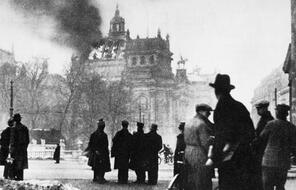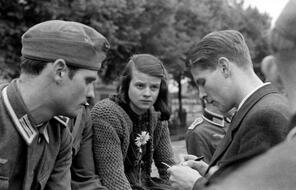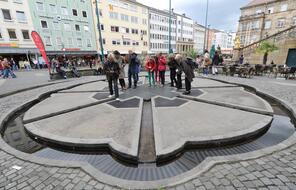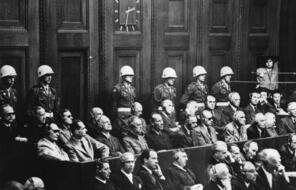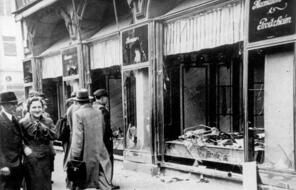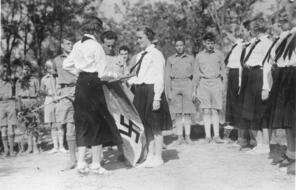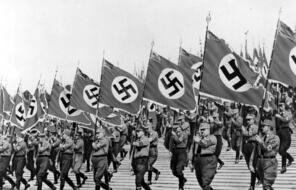Storm Troopers, Elite Guards, and Secret Police
Nazi politician Wilhelm Murr expressed the Nazis’ attitude toward their opponents: “We do not say an eye for an eye, a tooth for a tooth. No, he who knocks out one of our eyes will get his head chopped off, and he who knocks out one of our teeth will get his jaw bashed in.” 1 According to Rudolf Diels, the chief of the political department of the Berlin police, that attitude could clearly be seen on city streets: “Not only Communists but anyone who had ever expressed himself against Hitler’s movement was in danger.” 2
In order to intimidate, attack, or arrest their opponents, the Nazis employed their own paramilitary groups and secret police. A paramilitary group is an organized military-style force that is loyal to a political party or private organization instead of a government. Chief among these organizations were the SA (Sturmabteilung, which translates to “storm detachment”), the SS (Schutzstaffel, which translates to “protection squadron”), and the Gestapo (an acronym of the first letters of Geheime Staatspolizei, or “secret state police”).
The SA had been around almost as long as the Nazi Party itself. SA members were known as “storm troopers” or “Brown Shirts” (because of their brown uniforms). They marched and brawled in the streets, intimidating opponents of the Nazis, during the years of the Weimar Republic (see reading, Violence in the Streets in Chapter 4). Now that the Nazis were in charge, the SA continued to operate outside the law, and it encountered very little opposition in early 1933. Indeed, many people openly supported its efforts. In a short story, Christopher Isherwood, a British writer living in Berlin around this time, describes some Germans’ response to the storm troopers:
They smiled approvingly at these youngsters in their big, swaggering boots who were going to upset the Treaty of Versailles. They were pleased because it would soon be summer, because Hitler had promised to protect the small tradesmen, because their newspapers told them that the good times were coming. They were suddenly proud of being blond. And they thrilled with a furtive, sensual pleasure, like schoolboys, because the Jews, their business rivals, and the Marxists, a vaguely defined minority of people who didn’t concern them, had been satisfactorily found guilty of the defeat and the inflation and were going to catch it. 3
The SS, too, had been created by the Nazis during the years of the Weimar Republic. At first, its members were Hitler’s personal bodyguards. Because he believed they were especially loyal to him, Hitler expanded the SS into the Nazi Party’s elite guard. Heinrich Himmler, as head of the SS, believed that its members ought to represent not only Germany’s military elite but also the nation’s “racial elite.” Each recruit was carefully screened, and each had to prove his family was “Aryan” dating back to at least 1750. Not only did every member of the SS have to pass the test but so did his prospective bride. The SS would grow to become one of the chief agents of terror and mass murder under the Nazi regime. The SS operated the concentration camp at Dachau that was opened in 1933, as well as the camps the Nazis built over the next 12 years. The SS also established an intelligence unit that spied on Germans and arrested, interrogated, and often imprisoned those they considered enemies of the nation.
Like the SS intelligence unit, the Gestapo spied on Germans to identify political opponents and dissenters and to arrest and question them. This secret police force was created on April 26, 1933, under the leadership of Hermann Göring. The Gestapo was authorized to “protect public safety and order” by using methods that ranged from interrogation to sending people to “private prisons” and later to concentration camps. Historian Richard Evans writes that the Gestapo became a symbol of Nazi terror, known for brutal interrogation techniques: “From the very beginning of the Third Reich, interrogations by the police and the Gestapo often resulted in prisoners being returned to their prison cells beaten, bruised, and badly injured to a degree that could not escape the attention of defending lawyers, relatives and friends.” 4
Connection Questions
- How does Christopher Isherwood’s account help to explain the enthusiasm some Germans felt for the Nazis when they came to power? How do you explain this enthusiasm?
- How important were the SA, the SS, and the Gestapo in Germany’s transformation from democracy to dictatorship? In what ways did the actions of each organization contribute to the transformation?
- 1Quoted in Joachim C. Fest, Hitler (San Diego: Harcourt Brace Jovanovich, 1992), 400.
- 2Ingo Müller, Hitler's Justice: The Courts of the Third Reich (Cambridge, Mass.: Harvard University Press, 1991), 50.
- 3Christopher Isherwood, The Berlin Stories (New York: New Directions, 1945), 179.
- 4Richard J. Evans, The Third Reich in Power (New York: Penguin, 2005), 75.
How to Cite This Reading
Facing History & Ourselves, “Storm Troopers, Elite Guards, and Secret Police”, last updated August 2, 2016.


